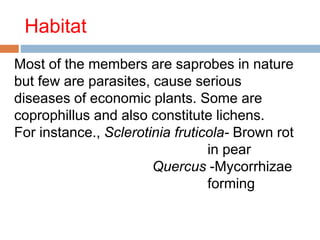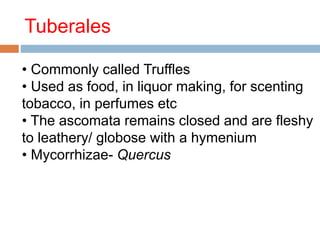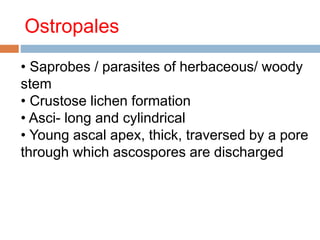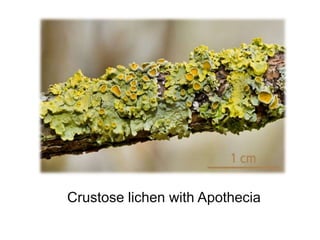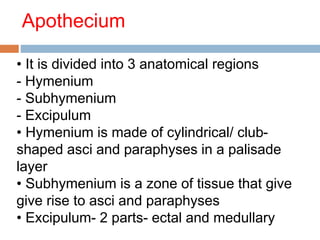Discomycetes
- 2. Contents • Introduction • Habitat • Classification • Apothecium Structure • Conclusion • Reference
- 3. Introduction A vast group-2,720 genera and 28,650 species. This includes the members with cup-shaped/ saucer-shaped, some are club-shaped, mushroom-like, sponge-like etc.. These produce fructification called Apothecium, is the main feature of identification. Discomycetes are Ascomycetes with apothecium.
- 4. Habitat Most of the members are saprobes in nature but few are parasites, cause serious diseases of economic plants. Some are coprophillus and also constitute lichens. For instance., Sclerotinia fruticola- Brown rot in pear Quercus -Mycorrhizae forming
- 5. Classification Discomycetes- grossly classified- based on the presence/ absence of Operculum. • Inoperculate • Operculate
- 6. Ainsworth divided Discomycetes into 6 orders viz., • Pezizales • Tuberales • Rhytismatales • Ostropales • Helitiales • Cyttariales Each order contains some families and few genus
- 7. Pezizales • Largest of operculate Discomycetes usually saprobes on soil, dead wood, plant debris/ humus • Apothecia may be fleshy/ brittle/ leathery / rarely gelatinous • The asci are arranged in a distinct hymenium with paraphyses • Edible- Morchella esculenta
- 8. PEZIZA BADIA PEZIZA CEREA
- 9. Tuberales • Commonly called Truffles • Used as food, in liquor making, for scenting tobacco, in perfumes etc • The ascomata remains closed and are fleshy to leathery/ globose with a hymenium • Mycorrhizae- Quercus
- 10. TUBER RUFUM
- 11. Rhytismatales(Phacidiales) • Saprobes/ plant parasites on leaves and wood • Produce characteristic apothecoid ascocarps immersed in a stroma/ host tissue • Asci are inoperculate and apically thick Rhytisma
- 12. Ostropales • Saprobes / parasites of herbaceous/ woody stem • Crustose lichen formation • Asci- long and cylindrical • Young ascal apex, thick, traversed by a pore through which ascospores are discharged
- 13. Crustose lichen with Apothecia
- 14. Helotiales • Inoperculate forms • Saprobes on soil, dead wood, dung and parasites that cause plant diseases (Sclerotinia spp.) • Ascocarps may be superficial or immersed in substratum
- 15. Cyttariales • Large ascomata-spherical to pyriform • Asci are operculate • Cushion of epiplasm remains between ascospores CYTTARIA ESPINOSAE
- 16. Apothecium • It is divided into 3 anatomical regions - Hymenium - Subhymenium - Excipulum • Hymenium is made of cylindrical/ club-shaped asci and paraphyses in a palisade layer • Subhymenium is a zone of tissue that give give rise to asci and paraphyses • Excipulum- 2 parts- ectal and medullary
- 18. Stages of Ascospore formation
- 19. Conclusion The members commonly produce asci within apothecium, may be operculate/ inoperculate. Morchellaceae under Pezizales has the members like mushrooms, which resemble the mushrooms.
- 20. Reference • R.S. MEHROTRA & K.R. ANEJA (2010) AN INTRODUCTION TO MYCOLOGY Pg no. 363-389 New Age International (p) Ltd., Publishers • JOHN WEBSTER, 1970, Introduction to fungi, pg no. 246-272. Cambridge university press •http://www.symbiology.com/pdf/Gargas7 .pdf



